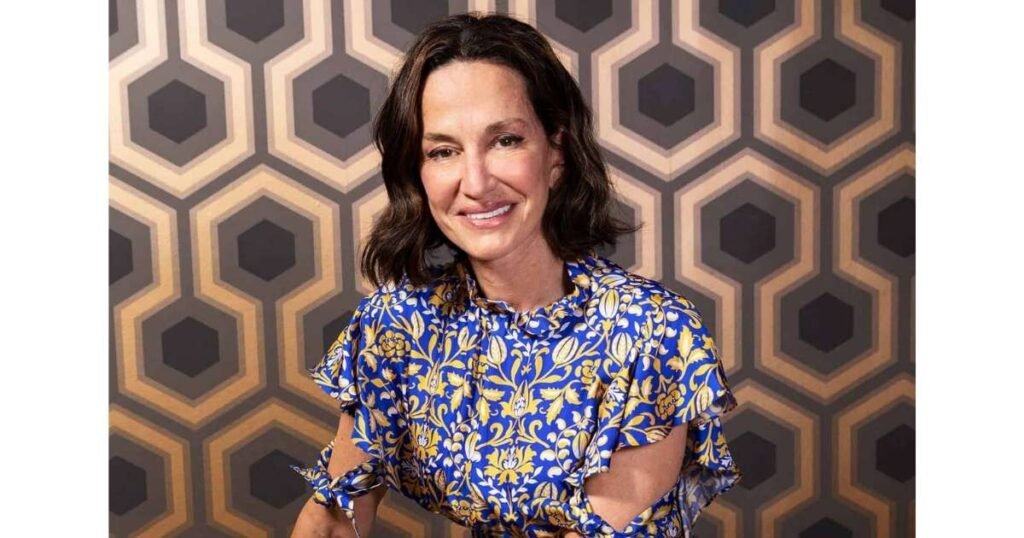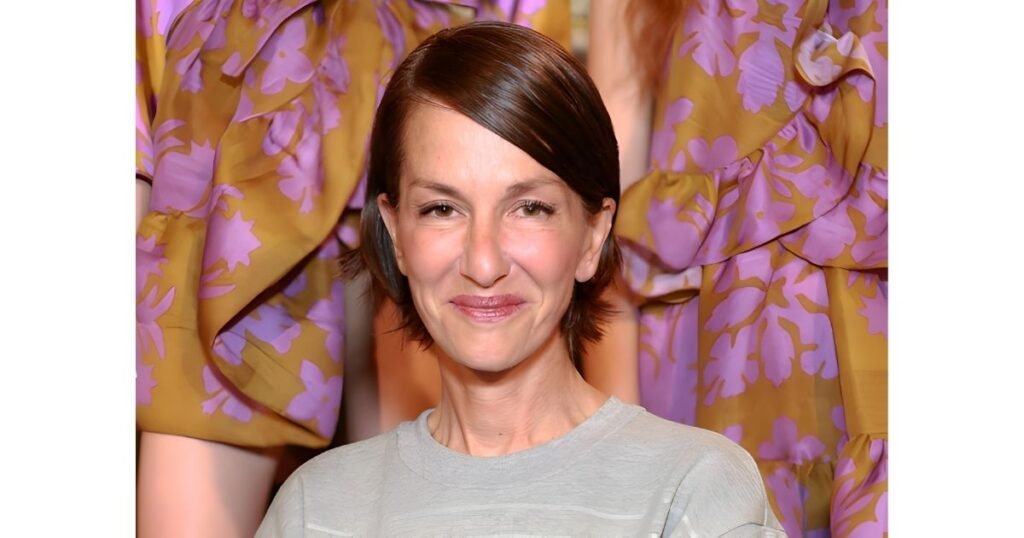Cynthia Rowley, a renowned American fashion designer, has created one of the most powerful lifestyle brands in the fashion world. Famous for her bold colors, wearable art, and creative design approach, she transformed her artistic talent into a successful business empire. By 2025, her net worth is estimated to reach $100 million, showcasing her years of hard work, entrepreneurial vision, and smart brand growth.
This article covers Cynthia Rowley’s net worth, income sources, brand value, personal life, and financial achievements. It also highlights how her early passion for creativity grew into a global fashion empire and the valuable lessons her story provides for future entrepreneurs.
Cynthia Rowley Wiki/Bio
| Attribute | Details |
| Full Name | Cynthia Rowley |
| Birth Date | July 29, 1968 |
| Age (2025) | 57 years |
| Birthplace | Barrington, Illinois |
| Education | School of the Art Institute of Chicago (BFA) |
| Profession | Fashion Designer, Entrepreneur |
| Spouse | Bill Powers (Art Dealer) |
| Children | Kit Keenan, Gigi Clementine |
| Net Worth | $100 Million (2025) |
Cynthia Rowley Net Worth

How much is Cynthia Rowley worth? The answer sits comfortably at $100 million as of 2025; a figure that places her among the elite tier of American fashion designers who successfully monetized their creative talents. This valuation reflects not just clothing sales but a diversified portfolio including brand licensing deals, real estate holdings and strategic collaborations that continue generating revenue streams. Her estimated wealth showcases what happens when artistic vision meets calculated business strategy over sustained periods.
Unlike designers who experienced rapid rises followed by equally dramatic falls, Cynthia Rowley’s wealth accumulation followed a steady upward trajectory. She started in the 1980s with a single clothing line in New York City and methodically expanded into adjacent markets. Each new product category; from swimwear to home furnishings; was carefully chosen to align with her brand identity while reaching new customer segments. This measured approach to growth protected her from the boom-bust cycles that claimed many of her contemporaries.
The Cynthia Rowley brand value extends beyond simple dollar figures. Industry analysts estimate her company generates tens of millions annually through combined channels: direct retail sales, wholesale partnerships, licensing agreements and online commerce. Her Target collaboration alone introduced her designs to millions of mainstream shoppers who might never have entered a high-end boutique. This democratization of fashion didn’t cheapen her brand; it amplified it exponentially and created loyal customers across economic demographics.
Read More: Sara Saffari Net Worth 2025: Height, Ethnicity, and Gym
Sources of Income Beyond Fashion
Cynthia Rowley’s income sources read like a diversification textbook written by someone who understood market volatility before it became trendy to discuss. Her primary revenue obviously comes from fashion collections and ready-to-wear lines that built her initial reputation. However, she recognized early that relying solely on clothing sales created vulnerability to fashion’s notoriously fickle trends and economic downturns.
Her expansion into lifestyle products demonstrated brilliant strategic thinking. The Cynthia Rowley surf gear line caught many industry watchers by surprise; until they saw how it connected her bold design aesthetic with the growing wellness and outdoor recreation market. She created wetsuits that looked as good as they performed, attracting fitness enthusiasts who’d never considered high-fashion sportswear. Similarly, her eyewear collections, swimwear designs and handbag lines each tapped distinct consumer desires while maintaining cohesive brand identity.
Brand licensing became another cornerstone of her financial success. By allowing carefully selected partners to produce Cynthia Rowley-branded products, she earned royalties without the overhead of manufacturing everything herself. Her home décor collections brought her signature bold colors and playful patterns into living spaces. The Cynthia Rowley Target collaboration stands as perhaps her most visible licensing success; proving that mass-market partnerships could coexist with luxury positioning when executed with authenticity and quality control.
Early Life and the Spark of Creativity
Growing up in Barrington, Illinois, Cynthia Rowley experienced the kind of supportive childhood that creative entrepreneurs often cite as foundational. Her family didn’t just tolerate her artistic inclinations; they actively encouraged experimentation with fabrics, colors and design concepts. While other kids played with dolls, young Cynthia was already deconstructing and reconstructing clothing, treating each piece as a canvas for self-expression.
This early creative freedom shaped what would become her signature approach to fashion design. She never viewed clothing as merely functional items covering the body. Instead, Cynthia Rowley’s creative vision saw each garment as wearable art that could express personality, mood and individuality. Her childhood experiments with bold patterns and unexpected color combinations would eventually become the hallmark aesthetic that made her collections instantly recognizable on runways and retail racks.
The Cynthia Rowley early life story matters because it demonstrates how nurturing environments produce confident risk-takers. Her family’s encouragement gave her permission to push boundaries and trust her instincts; qualities that served her brilliantly when she later entered New York’s cutthroat fashion world. That small-town Illinois upbringing provided both creative foundation and work ethic that sustained her through decades of building a business empire.
Cynthia Rowley Education
The School of the Art Institute of Chicago played a transformative role in converting raw talent into professional capability. Enrolling in this prestigious institution exposed Cynthia to a community of artists, designers and creative thinkers who challenged conventional approaches to fashion. Her coursework went beyond pattern-making and garment construction to explore the theoretical and conceptual frameworks that elevated design from craft to art form.
Cynthia Rowley’s education background gave her something invaluable: confidence backed by technical mastery. She graduated with a Bachelor of Fine Arts degree that validated her skills while the interdisciplinary environment taught her to draw inspiration from painting, sculpture and architecture. This broad artistic education explains why her collections always felt more conceptually rich than typical commercial fashion; she was solving design problems through an artist’s lens rather than just following market trends.
Her time at the Chicago art college also revealed early signs of her distinctive voice. Fellow students and instructors noticed that even her student work featured the bold prints and vibrant colors that would later become synonymous with the Cynthia Rowley brand. The education didn’t just teach her how to make clothes; it taught her how to think about fashion as cultural commentary and personal expression, setting the stage for a career that would blur the lines between commerce and creativity.
Cynthia Rowley Family
Who is Cynthia Rowley married to? Her husband Bill Powers brings his own impressive credentials as an art dealer and gallerist, creating a household where creative and commercial sensibilities merge seamlessly. Their partnership represents more than romantic connection; it’s a strategic alliance between two people who understand how to build value in aesthetic markets. Bill’s work in the art world complements Cynthia’s fashion empire, and together they’ve created a lifestyle that authentically embodies the brand she sells.
Cynthia Rowley’s daughters names; Kit Keenan and Gigi Clementine; represent the next generation of this creative dynasty. Kit has already gained recognition through her own fashion ventures and media appearances, giving the Rowley brand intergenerational credibility. Gigi contributes to the family’s artistic energy in her own way. By incorporating her family into her public persona without exploiting them, Cynthia created authenticity that marketing campaigns can’t manufacture.
Family influence on her business decisions shows up in unexpected ways. The cross-generational appeal of her products isn’t accidental; it’s informed by living in a multi-generational household where she observes what resonates with different age groups. Her daughters’ perspectives help keep the brand current while her own experience ensures it maintains sophistication. This family integration transforms potential marketing liability into genuine brand strength that competitors struggle to replicate artificially.
The Launch of a Fashion Empire

Cynthia Rowley’s rise to fame began when she made the bold move to New York City in the 1980s; a decade when American fashion was finding its voice distinct from European dominance. She launched her first collection with limited resources but unlimited ambition, creating designs that immediately caught the attention of fashion editors and buyers. Her timing proved impeccable: the industry was hungry for fresh American talent that could offer something different from established names.
The CFDA Perry Ellis Award validated her emerging talent and gave her the industry credibility that opens doors. This recognition from the Council of Fashion Designers of America signaled that she wasn’t just another hopeful designer; she was someone with staying power. The award led to better retail placements, increased press coverage and the capital necessary to expand beyond a single clothing line into a diversified fashion business.
How Cynthia Rowley built her empire involved methodical expansion rather than explosive growth. She opened retail stores strategically, chose collaborations carefully and protected her brand identity even while scaling operations. Her Cynthia Rowley New York flagship became both revenue generator and brand showcase. Each business decision balanced creative integrity with commercial viability; a tightrope walk that many talented designers fail to master but she navigated with apparent ease
The Role of Branding in Her Wealth
Cynthia Rowley’s brand positioning transformed her from a designer into a lifestyle authority. She didn’t just sell dresses and accessories; she sold an entire aesthetic worldview that customers could inhabit through multiple touchpoints. This strategic expansion from fashion into home décor, fitness gear and everyday accessories created what marketers call “brand ubiquity” without dilution. Her bold colors and playful patterns became instantly recognizable whether on a wetsuit or a throw pillow.
The genius of her Target collaboration deserves special attention because it could have backfired spectacularly. Many luxury designers who’ve attempted mass-market partnerships saw their brand value plummet when customers perceived them as “cheap.” Cynthia avoided this trap by maintaining design integrity and quality standards even at lower price points. She proved that accessible doesn’t mean compromised; and in the process, she introduced millions of mainstream shoppers to her aesthetic who later became customers of her higher-end collections.
Cynthia Rowley’s brand success also stemmed from consistency over decades. Her signature style evolved without abandoning core principles. Customers knew what to expect: bold design choices, wearable art and a sense of fun that made fashion feel accessible rather than intimidating. This consistency built trust and loyalty that translated directly into sustained revenue generation. Her brand became shorthand for a particular lifestyle approach; confident, creative and unapologetically vibrant.
Personal Life and Its Impact on Her Success
Cynthia Rowley’s personal life isn’t separate from her business; it’s integral to her brand authenticity. Living in New York City, she embodies the cosmopolitan lifestyle her products represent. Her Instagram feed doesn’t just showcase products; it reveals a life genuinely lived according to the aesthetic principles her brand promotes. This authenticity resonates powerfully with consumers increasingly skeptical of manufactured brand narratives.
Her relationship with Bill Powers demonstrates how personal partnerships can amplify professional success. His art world connections expanded her creative network while his business acumen complemented her design genius. Cynthia Rowley and Bill Powers relationship models the kind of supportive partnership that allows creative entrepreneurs to focus on their strengths while trusting someone else to handle complementary skills.
Family influence extends into product development in tangible ways. Raising daughters in the fashion world gave her insights into what younger consumers actually want versus what older designers assume they want. Kit Keenan’s media presence brings the brand to audiences who might not follow traditional fashion channels. This intergenerational dialogue keeps the Cynthia Rowley brand relevant across age groups; a feat many heritage fashion houses struggle to achieve despite massive marketing budgets.
Real Estate and Other Investments
Cynthia Rowley’s investments in real estate demonstrate the financial wisdom that separates temporarily wealthy creators from those who build lasting fortunes. Her property holdings in New York City alone represent significant asset appreciation over the decades. Real estate provides both personal luxury and financial security; properties can generate rental income, appreciate substantially and serve as collateral for business expansion capital.
Her diversification strategy extends beyond property into a financial portfolio designed to weather fashion industry volatility. While specific investment details remain private, industry observers note that successful fashion entrepreneurs typically allocate wealth across stocks, bonds and alternative investments. This approach protects against the risk of fashion relevance fading while creating passive income streams that don’t require daily management.
Cynthia Rowley’s financial portfolio reflects a long-term wealth building strategy rather than short-term consumption. Unlike some designers who spend lavishly and face financial trouble when trends shift, she’s built sustainable wealth through multiple asset classes. Her real estate holdings provide stability, her brand licensing generates ongoing royalties and her diversified investments create resilience. This financial architecture ensures that even if one revenue stream falters, her overall net worth remains protected.
Lessons From Cynthia Rowley’s Financial Journey
How Cynthia Rowley became successful offers a blueprint for creative entrepreneurs navigating the treacherous waters between art and commerce. First, she proved that creative vision must be paired with business acumen; neither alone suffices for sustained success. Her artistic training gave her distinctive voice but her business instincts told her when to expand, collaborate and protect her brand equity.
Diversification emerges as perhaps the most critical lesson from her journey. By expanding beyond clothing into lifestyle products, she created resilience against fashion’s inevitable shifts. When one product category underperforms, others compensate. Her surf gear might appeal to different customers than her eyewear, but both contribute to overall revenue stability. This multi-stream approach protects wealth in ways that single-product businesses never achieve.
Cynthia Rowley’s success secrets include authenticity as business strategy. She didn’t manufacture a persona disconnected from her actual life; she lived the lifestyle her brand represented. This genuine approach built customer loyalty that withstood economic downturns and competitive pressures. For aspiring entrepreneurs, her career demonstrates that the most sustainable brands emerge from authentic expression rather than calculated market positioning alone.
FAQ’s
What is Cynthia Rowley’s net worth in 2025?
Cynthia Rowley’s net worth in 2025 is estimated at $100 million, earned through her fashion empire, brand collaborations, lifestyle products, and real estate investments.
How did Cynthia Rowley become successful in fashion?
Cynthia Rowley’s success comes from her bold designs, creative vision, business strategy, and brand diversification into clothing, home décor, eyewear, and lifestyle products.
Where did Cynthia Rowley study fashion design?
Cynthia Rowley studied at the School of the Art Institute of Chicago, where she developed her unique fashion style and foundation for her successful design career.
What are Cynthia Rowley’s main sources of income?
Her income sources include fashion collections, lifestyle products, brand licensing, collaborations with major retailers, and investments in real estate, ensuring long-term financial stability.
Who is Cynthia Rowley married to?
Cynthia Rowley is married to Bill Powers, an art dealer and gallerist. They share two daughters, Kit Keenan and Gigi Clementine, who inspire her creativity.
Conclusion
Cynthia Rowley’s journey from a small-town artist to a world-famous fashion designer with a $100 million net worth is truly remarkable. Her success proves that thriving in the fashion world takes more than just talent; it requires strong entrepreneurial skills, diversification, and a focused branding strategy. By expanding her fashion empire beyond clothing into lifestyle products, surf gear, eyewear, and home décor, she ensured her brand’s lasting appeal across generations.
Her story goes beyond financial achievements; it’s also about balancing creativity with smart business decisions. From her early education at the School of the Art Institute of Chicago to her breakthrough in New York City, Cynthia Rowley has demonstrated that determination and innovation together lead to lasting wealth. Her investments in real estate and multiple income streams show the value of financial stability beyond fashion. For upcoming designers and entrepreneurs, her career teaches one key message: build with purpose, grow strategically, and keep innovating.

James Smith is the creative force behind Celebrity Meaning, bringing fans closer to their favorite stars by revealing the hidden meanings behind celebrity names. With a flair for fun facts and trending insights, James Smith keeps the site fresh, engaging, and full of star-powered stories!











